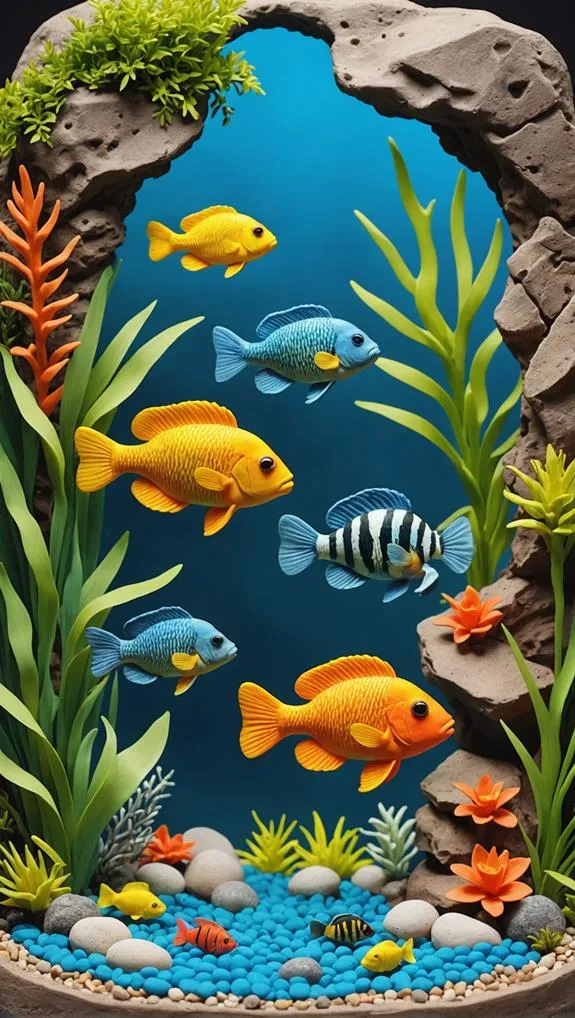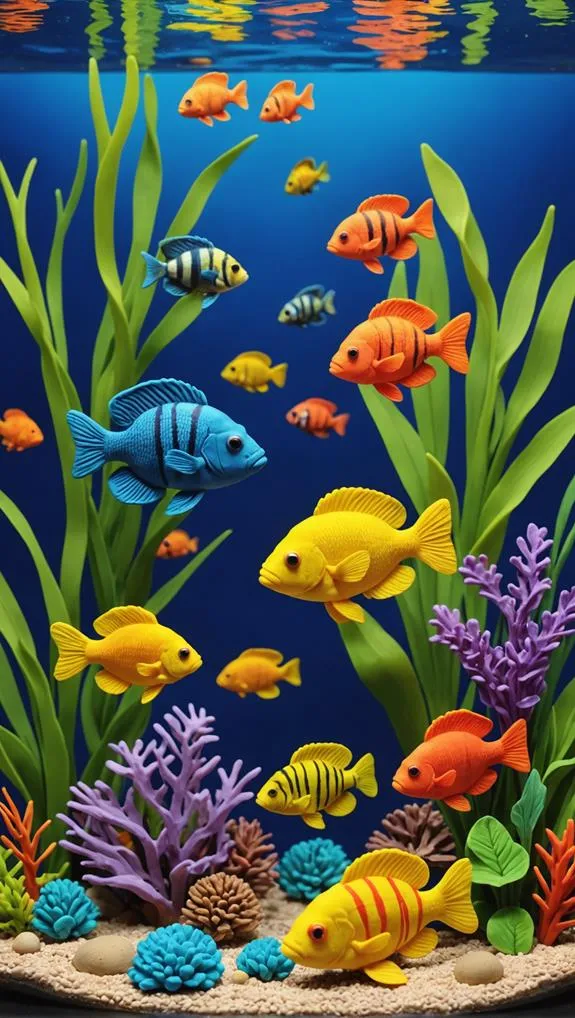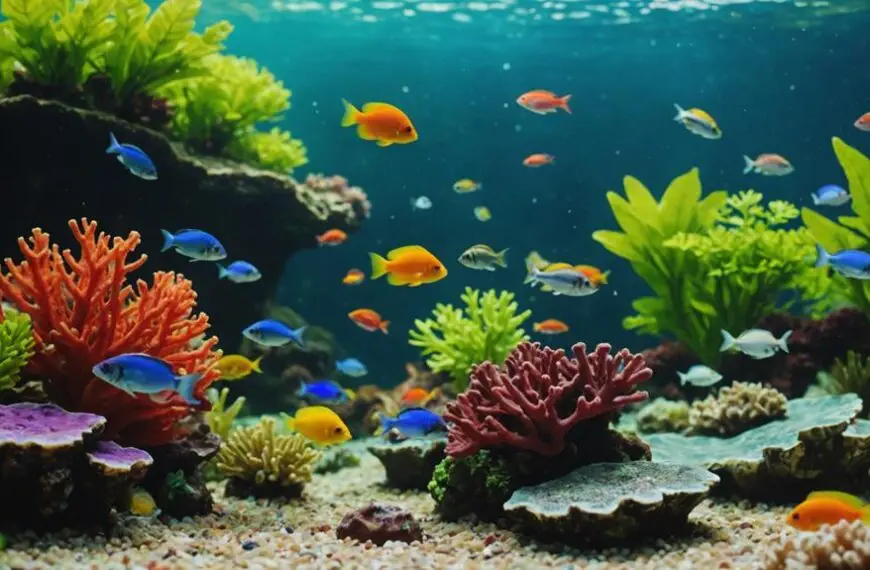The best feeding schedule for your cichlids is pretty simple! If you have juveniles, feed them twice daily with small portions they can gobble down in about 30 to 45 seconds. Adults? They'll be happy with just once a day. Just don't forget to skip a feeding day each week to let their tummies chill out and prevent obesity. Keep an eye on their behavior, too; if there's leftover food or they're acting hangry, you might need to adjust how much you're feeding. Want to unlock more secrets to happy cichlids? Keep on exploring!
Contents
Feeding Frequency Guidelines
When feeding your cichlids, maintaining a consistent schedule is essential for their health and growth.
You'll want to feed juvenile cichlids twice daily. They're like growing kids—always hungry! Adults, on the other hand, can thrive with just one feeding a day.
Be careful not to overfeed, though; your fish should finish their meal within 30 to 45 seconds. If they don't, you might be dishing out too much, leading to waste and unhappy water quality.
To further promote their well-being, consider introducing a fasting day once a week. This helps regulate digestion and prevents obesity.
Cichlids may love to eat, but a little restraint goes a long way!
Dietary Needs of Cichlids
Understanding the dietary needs of cichlids is crucial for their health and vitality. These colorful fish aren't all the same; they've different tastes! For example, herbivores like Mbuna love munching on algae and plant matter, while carnivorous species, such as Haplochromis, thrive on high-protein foods.
You'll want to choose high-quality pellets or flakes designed specifically for cichlids, ensuring they're packed with the right nutritional content.
Juvenile cichlids generally need to be fed twice a day, while adults can often get by with just one feeding daily. However, don't forget that larger carnivorous types might need a few meals each week!
It's essential not to overfeed your fish, as that can lead to health issues. Aim to provide portions that can be consumed within 30-45 seconds.
Effective Feeding Techniques

Feeding your cichlids effectively is key to their overall health and happiness.
You'll want to feed them twice a day, offering small portions that they can finish within 30-45 seconds. This helps prevent overfeeding and keeps your water quality in check.
Using autofeeders can be a lifesaver for busy days when you might forget to feed your finned friends.
You can crush pellets into smaller pieces to encourage quicker munching and aid their digestive health.
It's also important to observe their behavior during feeding; this gives you clues about their food preferences and can help you make the necessary adjustments.
Don't forget to implement a fasting day each week.
This little break helps prevent obesity and promotes better digestive health among your cichlids.
Think of it as their "spa day" where they can relax (without food) and reset.
Avoiding Overfeeding Risks
To maintain the health of your cichlids, it's crucial to avoid the risks associated with overfeeding. Overfeeding can lead to obesity and various health issues, like bloating and digestive problems.
Additionally, monitoring your aquarium's water quality is essential, as leftover food can break down and contribute to toxic ammonia levels, which can stress your fish; ideally, ammonia levels should be at 0.0 ppm regular monitoring of water parameters.
So, it's essential to monitor portion sizes closely. A good rule of thumb is to offer only what your cichlids can eat in about 30-45 seconds. If you notice uneaten food floating around, you're probably dishing out too much!
Consider implementing a fasting day each week. It might sound harsh, but it helps keep your aquarium fish healthy and prevents those pesky overfeeding-related issues.
Plus, it gives you a break from the daily feeding routine—win-win!
Always keep an eye on water quality, as leftover food can break down and cause ammonia spikes. Regularly remove any uneaten food to keep everything in check.
If your cichlids seem hesitant to eat or show signs of aggression during feeding, it might be a sign to reduce amounts.
Observing Fish Behavior

Watching your cichlids during feeding time can reveal a lot about their behavior and preferences. You'll notice how excited they get, swimming around eagerly as they anticipate their meal. This excitement is a good sign of healthy feeding habits.
However, if your cichlid fish consistently leave uneaten food, it might be time to reconsider the portion sizes. You don't want to be the one overfeeding them, right? Regular monitoring of your tank's water quality is also essential, as stress from poor conditions can affect their feeding behavior.
Changes in their behavior, like becoming less eager or spitting out food, can signal digestive issues or indicate that dietary tweaks are needed. Some species can be quite aggressive when it comes to food, so keeping an eye on their interactions can help you create a balanced feeding schedule that meets everyone's needs.
After feeding, don't forget to check the fecal color and consistency. Normal feces mean good dietary health, while abnormal colors could be a red flag. By observing these subtle signs, you'll better understand your cichlids' feeding preferences and overall well-being.
Frequently Asked Questions
How Often Should You Feed Cichlids?
You should feed your cichlids based on their species and growth stage. Juveniles thrive on two to three feedings daily, while adults need once daily. Monitor their behavior and adjust feeding frequency for optimal cichlid health.
Can Cichlids Go 3 Days Without Food?
Cichlids can indeed fast for three days, but watch for stress indicators like lethargy. Proper cichlid nutritional needs are vital; consider food types, growth rates, and water quality impacts when evaluating their health and behavior changes.
What Is the Best Feeding Schedule for Fish?
When considering the best feeding schedule for fish, prioritize their nutritional needs. Adjust portion sizes and food types based on growth stages, while maintaining tank conditions and water quality for optimal health and feeding habits.
What Are African Cichlid Eating Habits?
Did you know that 80% of African cichlids thrive on plant-based diets? Understanding their eating habits—like cichlid food types and preferences—ensures optimal health during growth stages, breeding, and territorial feeding in their natural habitat.
Final Thoughts
Finding the best feeding schedule for your cichlids is a bit like tuning a musical instrument; it takes time and attention to get it just right. By understanding their dietary needs and observing their behavior, you can create a routine that keeps them healthy and happy. Remember, moderation is key—overfeeding can lead to problems. So, keep an eye on your fish, adjust as needed, and enjoy the vibrant life they bring to your aquarium!












